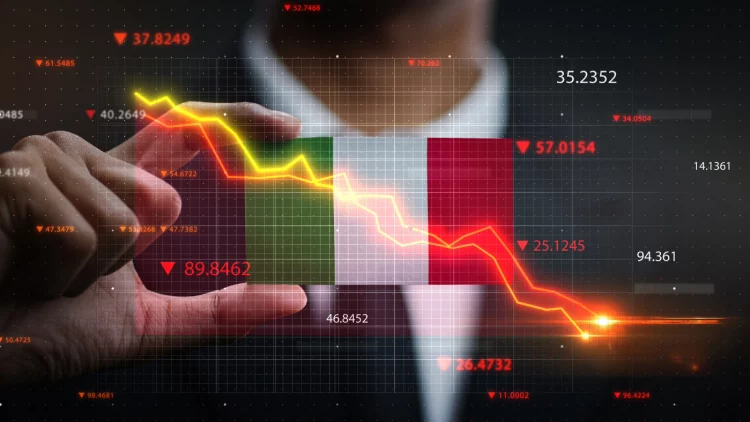Introduction
Italy’s public debt has long been a concern for both the Italian government and the broader European Union. As one of the largest economies in the Eurozone, Italy’s financial stability is critical not only for its own economic health but also for the well-being of the entire region. Over the years, Italy has faced multiple debt crises, and although it has managed to avoid a full-blown catastrophe, the risk of another economic storm is always looming. This article will examine Italy’s current debt situation, the potential risks it poses to the Eurozone, and how investors can navigate these challenges.
1. Analyzing Italy’s Current Debt Situation and the Risks it Poses to the Eurozone
Italy’s public debt currently stands at over 150% of its GDP, one of the highest in the world. Despite this high debt load, Italy has managed to avoid immediate economic collapse, largely due to the support it receives from the European Central Bank (ECB) and the Eurozone. However, several factors contribute to the ongoing risks posed by Italy’s debt situation:
- Slow Economic Growth: Italy has faced sluggish economic growth for much of the past two decades, compounded by structural issues such as an aging population, low productivity, and high unemployment. This weak economic performance makes it difficult for Italy to generate the necessary revenue to reduce its debt burden effectively.
- Rising Debt Servicing Costs: As Italy’s debt grows, so too does the cost of servicing it. With interest rates remaining low in recent years, Italy has managed to keep debt servicing costs relatively under control. However, any future rise in interest rates, whether due to ECB policy changes or external factors, could significantly increase Italy’s debt burden.
- Political Instability: Italy’s political landscape has long been unstable, with frequent changes in government and a fragmented political system. This instability can undermine investor confidence and make it difficult for Italy to implement necessary economic reforms or manage its debt effectively.
- Banking Sector Vulnerabilities: Italy’s banking sector, burdened by non-performing loans and low profitability, remains another weak point in its financial system. A crisis in the banking sector could exacerbate Italy’s debt crisis, as it would likely require substantial government intervention to prevent a banking collapse.
The risks posed by Italy’s debt are not confined to the country itself. Due to its size within the Eurozone, any financial turmoil in Italy would have a ripple effect throughout the region. A potential default or debt restructuring could lead to significant volatility in European markets, particularly in countries with close economic ties to Italy.
2. The Role of the European Central Bank in Mitigating Potential Crises
The European Central Bank (ECB) has played a critical role in mitigating Italy’s debt crisis, and it is likely to continue doing so in the future. The ECB has implemented several key measures to support Italy and other Eurozone countries facing financial stress:
- Monetary Policy: The ECB has kept interest rates low for an extended period, helping to keep Italy’s borrowing costs manageable. Additionally, the ECB’s bond-buying programs, such as the Public Sector Purchase Programme (PSPP), have helped reduce yields on Italian government bonds and provide liquidity to the market.
- Fiscal Support: Although the ECB does not directly engage in fiscal policy, its actions have provided a safety net for Italy. In the event of an economic crisis, the ECB could act as a lender of last resort, providing liquidity and helping to stabilize the financial system.
- Bailout Mechanisms: While the ECB’s mandate does not allow it to directly intervene in national debt crises, the European Union has created mechanisms like the European Stability Mechanism (ESM) to provide financial assistance to countries in need. Italy, as a member of the EU, could potentially access this assistance if its debt situation worsens significantly.
- Financial Regulation and Oversight: The ECB also plays a role in overseeing the financial stability of the Eurozone, including monitoring Italy’s debt levels and banking sector health. This regulatory oversight can help identify potential risks before they escalate into crises.
However, despite these interventions, the ECB’s ability to prevent a full-blown debt crisis in Italy is not guaranteed. Any future economic or political developments that weaken Italy’s financial position could strain the ECB’s capacity to manage the situation.

3. The Broader Impact of Italy’s Financial Troubles on European Markets
Italy’s debt crisis, if left unaddressed, could have a far-reaching impact on European markets. As one of the largest economies in the Eurozone, Italy’s financial troubles could trigger broader market instability, affecting other European countries and investors. Key potential impacts include:
- Market Volatility: A significant worsening of Italy’s debt situation could lead to sharp declines in European stock markets, particularly in Italy and other southern European economies. Bond markets could also see increased yields as investors demand higher compensation for the risk of holding Italian debt.
- Banking Sector Impact: A financial crisis in Italy could lead to a banking crisis, particularly if Italian banks are forced to write down non-performing loans. This could have a contagion effect on other European banks, particularly those with significant exposure to Italian debt.
- Weakened Investor Confidence: If Italy’s debt situation worsens, it could undermine investor confidence in the Eurozone as a whole, leading to capital outflows and reduced foreign investment. This could exacerbate economic downturns in other Eurozone countries, particularly those with weaker economies.
- Potential for Spillover into the Global Economy: Given the interconnectedness of global financial markets, a crisis in Italy could have ripple effects beyond Europe. Investors in global markets could become more risk-averse, leading to declines in equity markets and a flight to safe-haven assets like U.S. Treasury bonds or gold.
4. Expert Views on How Investors Should Prepare for Possible Volatility
Experts suggest that investors should remain cautious when it comes to Italian debt and the broader Eurozone market. While Italy has managed to avoid a full-blown crisis thus far, the country’s debt levels and economic challenges remain significant risks for investors. Here are a few strategies for navigating the potential volatility:
- Diversification: One of the best ways to protect against the risks posed by Italy’s debt crisis is to diversify investments across regions and asset classes. This reduces exposure to any single country or market, including Italy, and helps protect against potential shocks.
- Focus on Safe-Haven Assets: In times of heightened risk, many investors turn to safe-haven assets like gold, U.S. Treasuries, and other government bonds with low risk of default. These assets tend to perform well during periods of market volatility and can serve as a hedge against broader financial instability.
- Monitor the Banking Sector: Italy’s banking sector is one of the most vulnerable parts of its economy, and any signs of trouble could signal broader financial instability. Investors should keep a close eye on Italian banks and their exposure to government debt, as well as any regulatory changes that may affect the sector.
- Stay Informed on ECB and EU Responses: The actions of the ECB and the EU will play a crucial role in managing Italy’s debt crisis. Investors should stay informed on any new fiscal or monetary policies that may be implemented to stabilize the situation. ECB statements and actions, particularly regarding interest rates or bond-buying programs, will provide valuable signals on the health of the Eurozone economy.
Conclusion
Italy’s debt crisis is a pressing concern for both the country and the broader Eurozone. While the European Central Bank has played a pivotal role in mitigating risks, the potential for market volatility remains high. Investors should remain vigilant, diversifying their portfolios, focusing on safe-haven assets, and closely monitoring developments in Italy’s banking sector and the actions of the ECB. By staying informed and prepared, investors can navigate the uncertainties surrounding Italy’s debt and position themselves for potential opportunities in this volatile environment.





























